We finally made it. After a very long 15 months, we managed to travel to Germany and see the family. Hooray. But quite a few things had changed since we last went over in summer 2020. Travel restrictions due to the ongoing pandemic, Brexit coming into full effect, as well as taking a dog over to mainland Europe for the first time. Even as a seasoned traveller, I found it super confusing to work out what paperwork we would need. So, I thought I’d give you a little run down of everything we needed to travel to Germany and back to the UK at these uncertain times. But please don’t take this as a check list for your own travels. If you are planning on travelling, I would urge you to check the respective government websites yourself. Travel restrictions and requirements change all the time, and I wouldn’t want you to get stuck somewhere along the way because you had the wrong documents (or were missing a test).
I am not sure what was more distracting when planning our trip. Working out what kind of documents and tests we would need for each country we would pass on our journey? Or ensuring we wouldn’t pack anything no longer acceptable post Brexit. And what about the dog? I have already given you the highs and lows of travelling with a dog post Brexit (well, only the lows really, I have yet to find any highs). It seems, every time I checked all details online, things had changed.
Travelling to Germany and back: Planning our route
We’ve travelled between England and Germany numerous times. Our usual route would be the ferry from Dover to Calais or Dunkirk, then a car journey through France, Belgium, and Luxembourg, before arriving in Germany. Even last year, when we last travelled to Germany after the first lock down in the UK we took that route, including the ferry. However, this time we changed our plans a little. For two different reasons:
For one, our dog. Had we taken the ferry, as we normally would do, our little puppy would have needed to stay in the car for the entire crossing. Whilst he is fine with long car journeys by now, he’s never really stayed in the car on his own. And we were worried that it would freak him out staying in the car for 90 minutes without us. And with loads of cars around him sounding their alarm (as it seems loads of people don’t know how to lock their car without activating the alarm… resulting in them all setting off the moment the ferry starts its engines).
So, instead we decided to take the train through the Eurotunnel. Which was a lot easier and quicker (albeit a little more expensive). And meant we would all stay in the car, not just the dog.
The other change to our itinerary was the number of countries we would cross. Almost every country has a different set of requirements for entering and transiting. So, rather than ensuring we had all relevant paperwork for four different countries along the way, we decided to choose a simpler route that would only transit through France and directly into Germany. Unfortunately, this turned out to be more expensive, as we would have to pay the toll for French motorways. And wouldn’t be able to fill up the car with cheaper petrol in Luxembourg. But we still considered it worth it. Less paperwork and a lot less traffic (the plus side of a country charging for its motorways… hardly any local bothers to take it).
Travelling to Germany and back: Preparations
Booking the Eurotunnel shuttle and working out our travel route weren’t the only things to prepare before travelling.
Where in normal times this would have sufficed (along with grabbing our ID cards or passports on the way out), we now had a few more things to consider.
Checking the UK, French and German government websites, we worked out that we would need a couple of documents to travel to Germany.
As we are both fully vaccinated, things weren’t as complicated as they could have been, so at least we knew we wouldn’t have to quarantine anywhere.
As we were only transiting through France, we only needed to fill in a sworn declaration that we weren’t in contact with anyone with Corona recently and that to our knowledge we weren’t positive either. We printed out the form in English from the French government site and filled it in. But TBH, no one checked that document on the way to Germany or back to the UK.
Next, each of us had to fill in a ‘Digitale Einreiseanmeldung’ (digital entry form) for Germany. This needed to be done before entering Germany and would detail our vaccination status, where we had been in the 10 days prior and where we would be staying in the coming 10 days. Once submitted, we had the option to print it or save it as a digital version. To be on the safe side, I printed it all, just in case.
We also had our NHS vaccination certificate with us. Both as a hard copy and digitally in the NHS app.
For Frank the dog, we needed an Animal Health Certificate, that our vet had issued a few days before we travelled (once issued, it allows the dog to leave the UK within 10 days and come back within 3 months).
Lastly, we needed to check in for our Eurotunnel train. Adding our API (advanced passenger information, i.e. passport number etc), plus Frank’s chip number and details, plus confirming our vaccination status.
With all the documents ready, it was time to pack our bags. Until now, packing the car to head to Germany would include loads of goodies for friends and family. Tea and cheese, biscuits, chocolates, sweets for the kids, muesli for my aunt.
However, thanks to UK no longer being part of the EU, we now had to comply with the strict import rules in place for goods being taken into the EU. Meaning no dairy or meat products. No cheese or scotch eggs (don’t ask… a friend visited us a while back and absolutely fell in love with scotch eggs, so ever since I would bring her a box when we came by car), but also no muesli, chocolates, and a reduced selection of the biscuits (who would have thought so many products contained milk powder?). It also meant we weren’t allowed to take any dog food for the pup. Ahead of us travelling, my mum bought a big bag of dachshund food in Germany (a good thing little Frank isn’t too fussed with his food and doesn’t mind changing flavours at short notice).
Starting our journey
With all preparation done, Saturday morning it was finally time to travel. We had booked a train for 7.50am. Meaning a very early start, as we would need to arrive at Folkstone before 7am. Usually you would need to arrive 45 minutes prior to departure, however with a dog, they urged us to check in at least one hour before. And as this was the first time, we would ever take the Eurotunnel train, we had no idea how long check in would take, where we would need to go, how much hassle it was to get the dog checked in etc. That paired with the risk of hitting traffic (or any road closures along the way), we set our alarms for 3am. With the aim of being on our way by 4am latest. Which we managed to beat by a good 15 minutes, despite Mr T quickly walking the dog and loading the car (I can only imagine how keen the little pup was, being dragged out of bed and around the block in the pitch black in the middle of the night).
Well, to cut a long story short, we arrived at Folkstone far too early, and it all went quick and smooth.
Resulting in them offering us to board an earlier train. Instead of 7.50, we were able to board the 6.20 train. A full hour and a half early (but then, anyone that knows us, knows that we never ever actually travel on the ferry booked, so why should this be any different for the Euroshuttle).
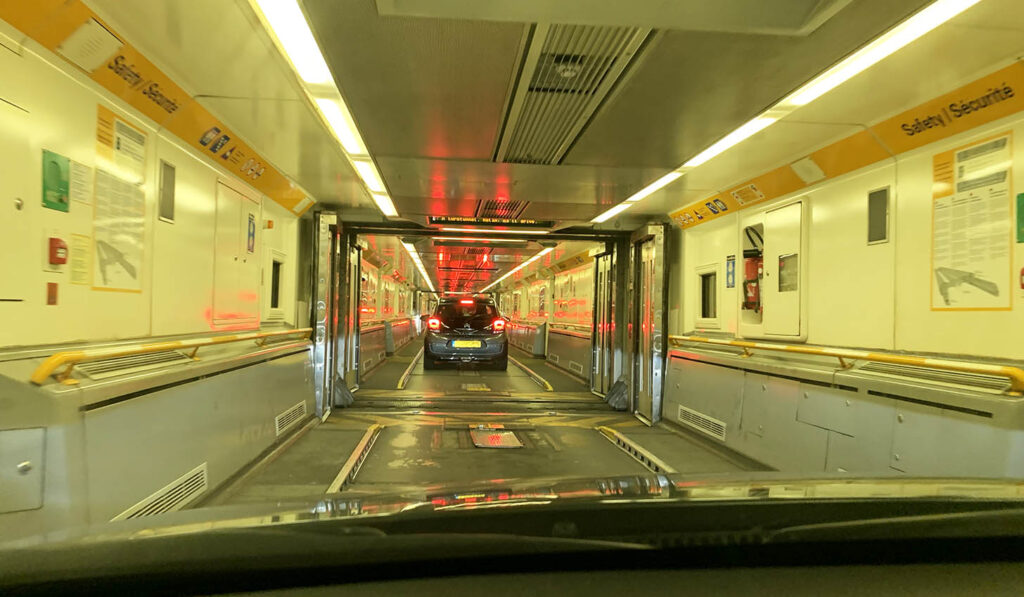
Once we arrived in Calais, we got off the train quick and easy. And were then allowed to just drive off. No further checks this side of the channel.
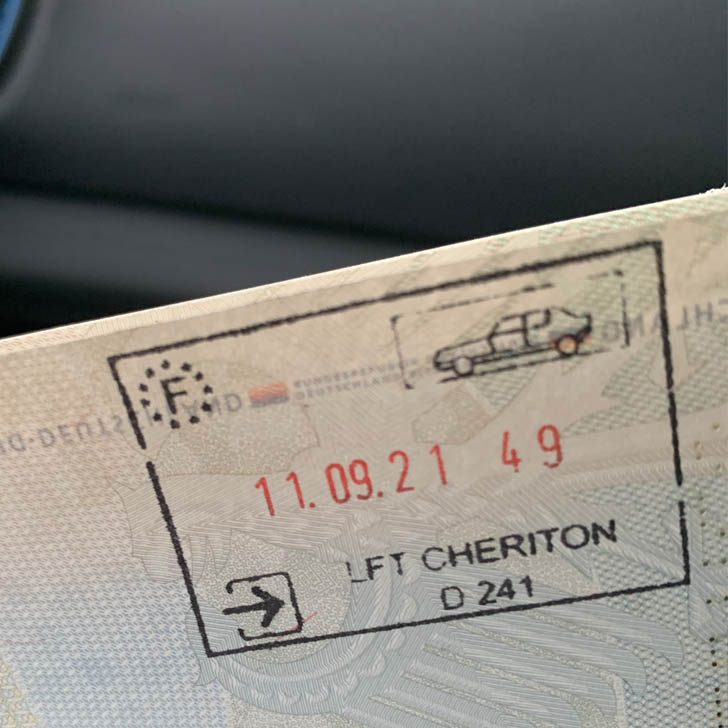
Travelling through France and into Germany
As already mentioned, we chose a route that would lead us through France directly into Germany, rather than crossing through Belgium and Luxembourg. So, once we got off the train, we went on our way. Not long until we reached the first toll booth. But with all of those using contactless cards nowadays, paying for French motorway isn’t as tricky as it used to be (yes, I am old enough to remember pre-Euro travel through France and the pain of having enough French Francs on you to pay the toll).
When approaching the French-German border, there were no checks in place whatsoever. With both countries being part of Schengen, this is normal, as no passports need to be checked. But we weren’t sure if there would be any check of vaccination status or entry forms in place. Well, there weren’t. So far, no one checked (or even asked for) that sworn statement, that we printed and filled in for France. Nor did we have to actually show the German entry form anywhere. I guess this might be different if we were to enter Germany by plane. But by car it appeared as if we had filled in a lot of paperwork, that no one was interested in. But then again, the digital entry form is linked to our passports, so I guess there was a chance of the German authorities just contacting us if they needed to check something or if some details weren’t right.

Holidaying in Germany
Before travelling, we had checked what the current regulations were in Germany. So, we knew that we would need FFP2 or surgical masks (having a fabric mask or using a bandana or scarf to cover your face isn’t sufficient in Germany, even though perfectly acceptable in the UK). Well actually, I was a little misinformed and thought only FFP2 masks were allowed in Germany. So ended up ordering a box of them before travelling.
Covid regulations in Germany vary by state. Whilst surgical masks are sufficient in Rhineland-Palatinate, where my parents live, Bavaria only allows FFP2 masks.
Same goes for the requirements when eating out, shopping etc.
Most states have a 3G system in place: Geimpft, Genesen, Getestet. So, in order to eat at a restaurant or go swimming or to the cinema etc, you will need to show proof of vaccination (Geimpft) or recovery (Genesen) or show a negative test result (Getestet). A few areas even have a 2G system in place: vaccinated or recovered.
To proof your vaccination status (and to check into venues), Germany uses different apps. We had downloaded both the Corona-Warn and Lucca app ahead of our trip. The Corona-Warn app is the one used to proof your vaccination status. However, it isn’t very straight forward loading a UK vaccination certificate in there, this was something the pharmacy needed to do for us. But once done, we could just show the certificate on there, same as everyone else. To be honest, I didn’t even try to get into venues using the NHS certificate, so I can’t tell you if it would have been sufficient or not. It should be and I guess in larger cities it won’t be a problem. But I wasn’t too sure in more rural areas, so thought I’d save me that hassle.
As for the Lucca app, you can easily download that before you travel and use it to check in and out of venues whilst in Germany. But no worries, if you don’t want to (or can’t) use an app, venues can sign you in manually.
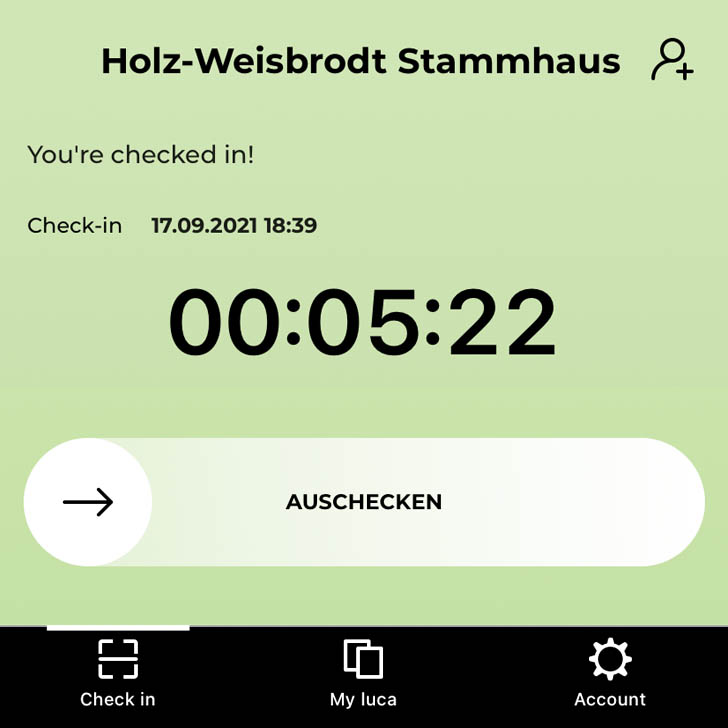
But these things aside, life felt fairly normal whilst on holiday in Germany. It was great to finally see our family and friends again.
Preparing to go back to the UK
We stayed in Germany for two weeks and very much enjoyed it.
But as with any holiday, it must eventually come to an end. Meaning we needed
to prepare for our trip back to the UK.
And same as with the journey out, it wasn’t a simple case of packing our bags
and loading the car. There were things that needed to be done ahead of us leaving
for the UK.
Firstly, the dog. Before travelling back to the UK, Frank needed a worm treatment. Administered by a vet, no more than 120 hours (5 days) before our travel. And all noted in his Health Certificate. To be honest, this had always been the case, even before Brexit. Back then, it would have just been noted in his pet passport, instead of the Health Certificate. This is a recurring cost, we always knew we had to add to our travel budget, whenever taking the dog to mainland Europe (and at 15 Euros, it luckily wasn’t too bad).
Next up, we needed some Covid testing. At the time of our trip, the UK required two tests, even if you were fully vaccinated. We needed a pre-departure test to be taken in the 3 days before our travel. And a day two test, to be taken within the first 2 days of arriving back in the UK.
We had booked our day two testing kits ahead of our trip, so that we knew the boxes were safely sitting at home, waiting for us to return.
As for the pre-departure test, this was the one we were a little unsure about. We found a testing centre near my parents, and we knew that they offered a free test, that in theory should be sufficient for travelling. What we didn’t know though was, whether or not we would get the required certificate in English language.
Our travel back to the UK would be on Saturday, so we booked the pre-departure test for Thursday afternoon. Giving us enough time to find an alternative if the certificates weren’t sufficient.
I can’t even tell you how anxious this test made me. It was a simple swap test, like the ones I would regularly do at home. But this was the first time someone else did the test for me. But that wasn’t necessarily what made me so anxious. What if the result was positive? We had met loads of family and friends over the two weeks (although avoiding large crowds of people best possible). And we had tested ourselves a few times during those two weeks, just to be sure. So, in theory, I couldn’t see a reason why that pre-departure test should come back with a positive result. But that doesn’t mean it couldn’t. And if it did, we would be screwed. As it would mean we couldn’t travel back to the UK for another two weeks (let alone the fact that most of our family would also have to go and get tested).
So, with all those horrible thoughts in my head, we went to the testing centre, got our test done in under five minutes (and a good 15 minutes before our actual time slot, as it wasn’t busy at all). And were told that we could download the certificate in English, once it was ready. Good good. All that was left, was to wait for the 30 minutes or so, it would take to get the result.
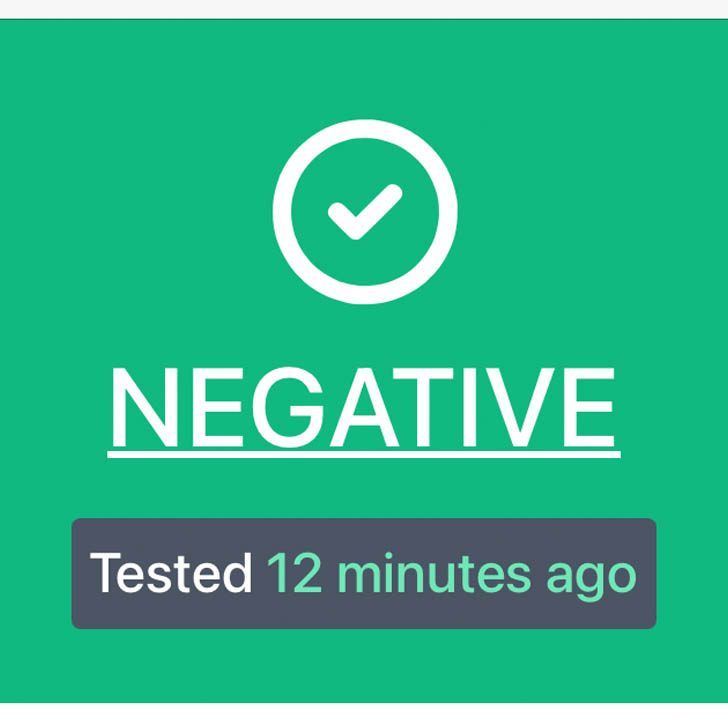
And what a relief, the tests came back negative. We were all set to travel back on Saturday. Or almost set.
Friday morning meant one last bits of administrative work ahead of our return journey. Going online and filling in the passenger locator form, that everyone travelling to the UK must fill in ahead of their arrival. This is something that was already in place last year when we went over to Germany, however now this passenger locator form not only included our whereabouts in the last 10 days (as it did last summer), but also proof of our vaccination status, the booking reference for our day two kit and confirmation that we had a negative pre-departure Covid test. Once it was all filled in and submitted, I downloaded it all and printed it (just to be safe). But I also received both passenger locator forms on email with a QR code in them, which we potentially would need to show at the border (spoiler alert, we didn’t).
Then we needed to check in for the Eurotunnel LeShuttle. This included uploading the negative test results for all passengers. Oh, and phoning their customer service, as we only then noticed that we booked Frank for the journey out of the UK, but somehow not coming back. A short call and 22GBP later Frank was also set to travel again.
Same as on the journey out, we printed and filled in the sworn declaration for France again (and again, no one really bothered with it).
Travelling back to the UK
Saturday morning it was time to say goodbye and finally head back to the UK. We opted for the same route through France only. And allowed plenty of time, so that we could stop regularly and take Frank for some walks in between. Again, there were no border controls in place between Germany and France. Once we arrived at Calais, we had to first check in the dog. They scanned his chip and checked his Health Certificate, then he was good to go. As for ourselves, we had to go through passport control on French and UK side (as normal), had to confirm that we had filled in the passenger locator form (although no one actually wanted to see it. But then again, I guess it is linked with our passports, so if we didn’t fill it in, it would flag). No customs check. But rules going back to the UK aren’t as strict as when entering the EU. So, meat and dairy products were fine. And we had ensured we stayed within our tax-free allowances for alcohol and gifts. So even if there would have been a check, we didn’t really have anything to worry about (other than the hassle of unloading the car for a thorough search, if you are very unlucky).
In true style, we arrived early enough to get on an earlier train (no surprise there, I know).

As our return journey coincided with the early stage of the UK fuel crisis, we ensured to fill up the car to the brim in France. Just in case, you never know. Turned out to be a good thing, as all petrol stations between Calais and home were shut with no fuel.
The day after, we did our day two tests and posted them to the lab. As it was a Sunday, it took a day longer for the tests to actually arrive at the lab, but by Tuesday evening, we both received emails, confirming that our tests had been negative. As double vaccinated people aren’t required to quarantine until the result is back, it didn’t really affect us much, but it was still a relief to know all is well and we could just get on with our life.
Whilst we were out in Germany, government announced that from October pre-departure tests were no longer required. Taking a massive, big anxiety trigger out of the whole travel palaver going forward.
So, was the whole faffing about worth it?
Well, for us it sure was. It was so good to finally see our families and friends again. Yes, it was a lot of paperwork and printing (although I guess I could have saved a tree or two and not bothered… but who knew that ahead of the journey).
We are already looking forward to heading over again for Christmas (probably shouldn’t say that as not to jinx it, so shhh, keep it quiet).
As we were travelling by car, we obviously managed to keep clear of people for most of our journey. Making us feel more in control of who we mix with. I guess, when flying, this would be a whole different experience. I haven’t boarded a flight since early March 2020. But it looks like this is also back on the cards for this month, so I’ll keep you updated if and when it happens.
OK, I hope I haven’t bored you too much, sharing our experience of travelling to Germany and back.
But tell me, have you been travelling this year? How different was your experience to years before?
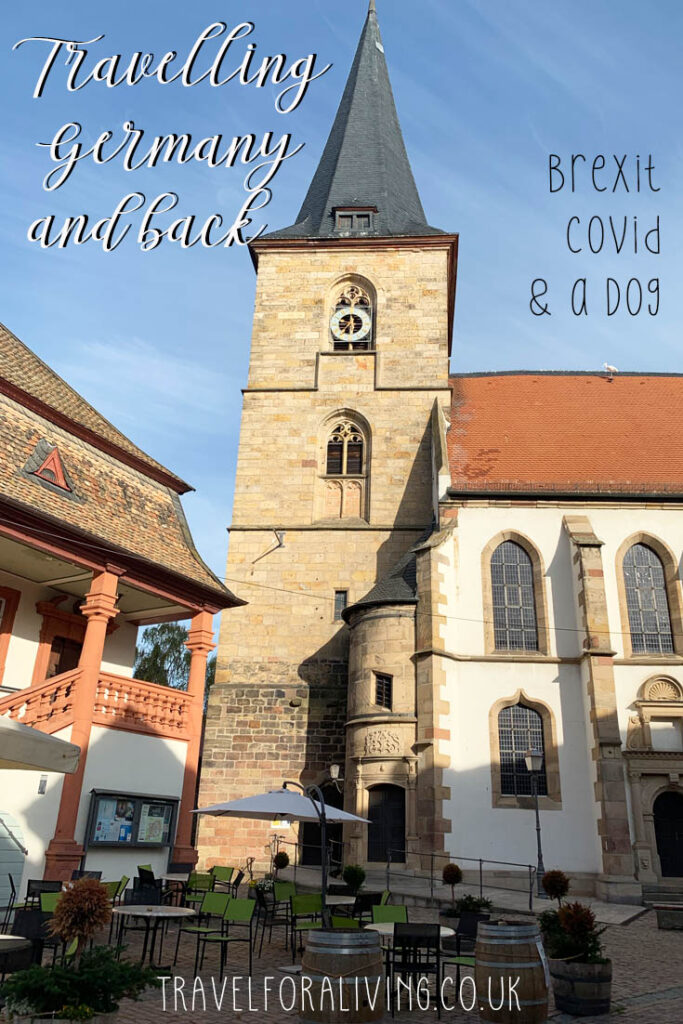

My first flight in a very long time - Travel for a Living
[…] was vaccinated in the UK. But courtesy of my recent trip to Germany, I do have a Germany issued EU vaccination certificate. So, in theory I should be fine to travel to […]